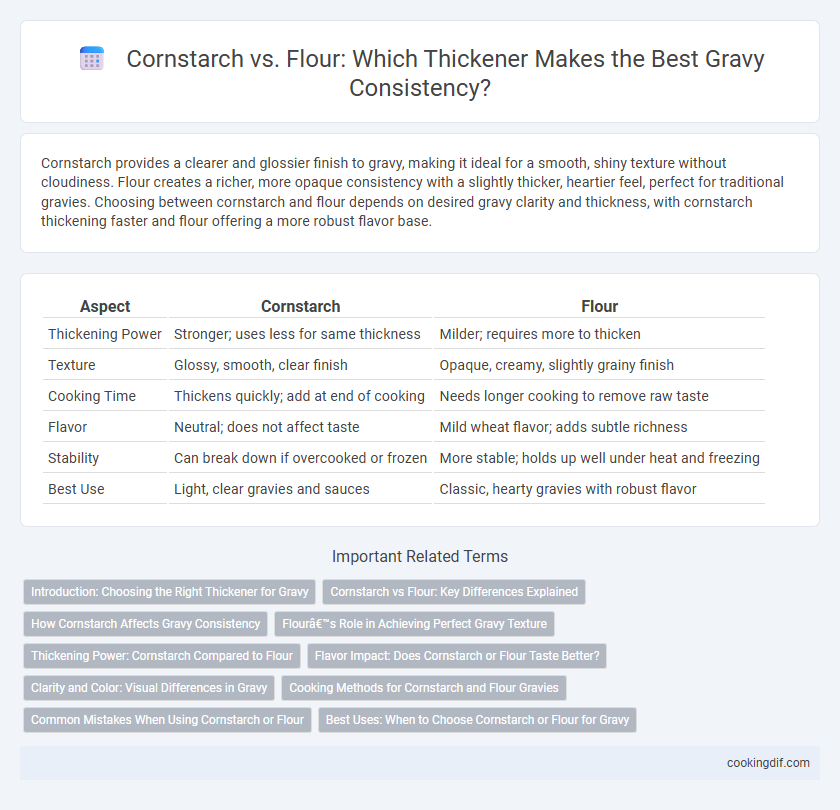Cornstarch provides a clearer and glossier finish to gravy, making it ideal for a smooth, shiny texture without cloudiness. Flour creates a richer, more opaque consistency with a slightly thicker, heartier feel, perfect for traditional gravies. Choosing between cornstarch and flour depends on desired gravy clarity and thickness, with cornstarch thickening faster and flour offering a more robust flavor base.
Table of Comparison
| Aspect | Cornstarch | Flour |
|---|---|---|
| Thickening Power | Stronger; uses less for same thickness | Milder; requires more to thicken |
| Texture | Glossy, smooth, clear finish | Opaque, creamy, slightly grainy finish |
| Cooking Time | Thickens quickly; add at end of cooking | Needs longer cooking to remove raw taste |
| Flavor | Neutral; does not affect taste | Mild wheat flavor; adds subtle richness |
| Stability | Can break down if overcooked or frozen | More stable; holds up well under heat and freezing |
| Best Use | Light, clear gravies and sauces | Classic, hearty gravies with robust flavor |
Introduction: Choosing the Right Thickener for Gravy
Cornstarch creates a clearer, glossier gravy with a thicker consistency using less quantity compared to flour, which yields a more opaque, creamier texture and adds a subtle nutty flavor. Cornstarch thickens at a lower temperature and requires mixing with cold water before incorporation to prevent lumps, while flour needs to be cooked in fat to form a roux, enhancing flavor and preventing a raw taste. Selecting between cornstarch and flour depends on the desired gravy appearance, texture, and taste profile for various dishes.
Cornstarch vs Flour: Key Differences Explained
Cornstarch and flour differ significantly in their thickening properties for gravy; cornstarch yields a glossy, translucent finish and thickens quickly at lower temperatures, while flour produces a more opaque, hearty texture but requires longer cooking to eliminate its raw taste. Cornstarch is roughly twice as potent as flour, so recipes call for less cornstarch to achieve the same consistency, making it ideal for smooth, clear gravies. Flour-based gravies benefit from a roux base to develop depth and prevent graininess, whereas cornstarch must be mixed with cold water as a slurry before adding to prevent clumping.
How Cornstarch Affects Gravy Consistency
Cornstarch creates a translucent, glossy gravy with a smooth, silky texture that thickens quickly when heated. Unlike flour, cornstarch requires less quantity to achieve the desired consistency and does not add a cloudy or pasty appearance. Its high starch content swells rapidly in hot liquid, providing a stable, velvety finish ideal for clear gravies and sauces.
Flour’s Role in Achieving Perfect Gravy Texture
Flour acts as a traditional thickening agent in gravy, creating a rich, smooth texture by forming a roux when cooked with fat, which evenly disperses the starch granules and prevents clumping. Its protein content contributes to a more velvety mouthfeel compared to cornstarch, which can produce a thinner, glossier finish. Using flour allows for gradual thickening and greater control over the gravy's consistency, resulting in a fuller-bodied sauce ideal for savory dishes.
Thickening Power: Cornstarch Compared to Flour
Cornstarch has approximately twice the thickening power of flour, allowing for a smoother and clearer gravy with less quantity needed. It creates a glossy finish and thickens quickly at lower temperatures, whereas flour requires longer cooking time and results in a more opaque, matte texture. Using cornstarch yields a more transparent consistency, ideal for delicate sauces and gravies.
Flavor Impact: Does Cornstarch or Flour Taste Better?
Cornstarch creates a glossy, smooth gravy with a neutral flavor that lets the natural taste of the ingredients shine through, while flour adds a slightly nutty, toasted flavor that can deepen the richness of the gravy. Flour-based gravy has a heartier texture and a more complex, savory taste due to the browning of flour during cooking. Cornstarch offers a cleaner, lighter flavor, making it ideal for delicate sauces where the focus is on the primary flavors.
Clarity and Color: Visual Differences in Gravy
Cornstarch creates a translucent, glossy gravy that enhances the clarity and preserves the natural color, making it ideal for lighter sauces. Flour-based gravy tends to be opaque and matte, resulting in a thicker, cloudier appearance with a creamier texture. Visual clarity is sharper with cornstarch, while flour produces a more rustic, traditional look in gravy.
Cooking Methods for Cornstarch and Flour Gravies
Cornstarch gravy requires mixing with cold water to form a slurry before adding to hot liquids, ensuring smooth thickening without lumps. Flour-based gravy necessitates cooking a roux by combining flour with fat over medium heat, allowing the flour to toast and develop a rich, nutty flavor while thickening the sauce. Cornstarch thickens more quickly and yields a translucent, glossy texture, whereas flour produces a creamier, opaque gravy with a deeper, more complex taste.
Common Mistakes When Using Cornstarch or Flour
Common mistakes when using cornstarch or flour for gravy include adding too much without properly dissolving it, leading to lumps and a gummy texture. Another error is not cooking the mixture long enough, which results in a raw, floury taste or a slimy consistency with cornstarch. Overheating cornstarch can break down the thickening power and cause the gravy to thin, whereas overcooking flour can darken the gravy undesirably.
Best Uses: When to Choose Cornstarch or Flour for Gravy
Cornstarch creates a glossy, translucent gravy with a smooth texture, ideal for quick-cooking recipes and lighter sauces, making it perfect when clarity and shine are desired. Flour thickens gravy with a rich, opaque consistency and adds a slightly nutty flavor, which works best for slow-cooked gravies and traditional, hearty dishes that benefit from deeper flavor development. Choose cornstarch for fast preparation and delicate sauces, and opt for flour when a robust, classic gravy texture and flavor are preferred.
Cornstarch vs Flour for gravy consistency Infographic

 cookingdif.com
cookingdif.com